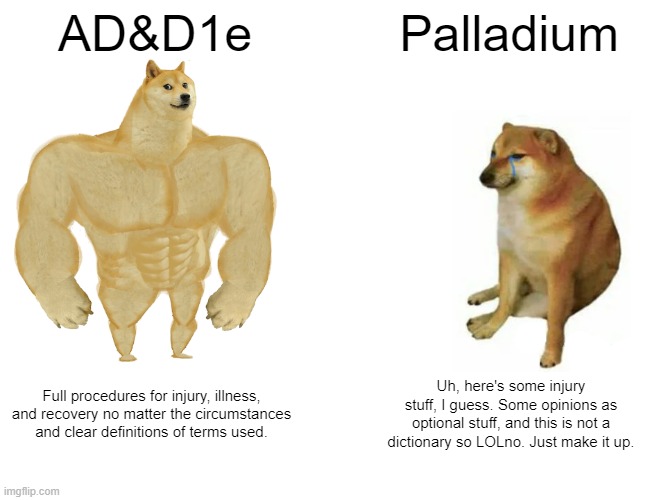(Following from yesterday's post.)
Injury is part of the game. Your man's going to get wounded, fall sick, get poisoned, suffer infections, etc. and need medical attention to overcome and recover.
A competent rules manual treats this with due seriousness and provides the user a clear set of procedures to handle all of this at the table. Incompetent ones half-ass it or ignore it.
Let's compare, shall we?

AD&D1e: Disease is in the DMG at pg. 13. It starts by stating that this procedure is an abstraction to confine the rules to what is useful, necessary, and proper for play. The Referee is expected to check each man each month for contracting a disease, increasing to a weekly check if circumstances are favorable and defines two common ones: hot and humid weather, or filthy and crowded conditions in warm weather. Checks are made every time the man is exposed to a carrier in a communicable manner. (Naturally, this extends to interiors also.)
Parasitic infestation is separately checked for at the same rate and with the same conditions accelerating checks to weekly affairs. Same check per exposure event also applies.
A percentile check is made, with conditions defined and modifiers given, for each check to be made. If failed, go to (respectively) the Disease or Parasitic Infestation table and see what malady afflicts the man. Only what is afflicted, how, and their gameplay effects are detailed; the Referee is at liberty to use whatever suits him for naming the malady.
What is missing is recovery for disease or infestation that doesn't involve magic. This is intentional. The threat is meant to be that severe; have a friendly healer nearby to use Cure Disease on your man, or watch him wither away. Prevention is meant to be part of a skilled player's well-honed habits; savvy, #EliteLevel players make certain to have a potion-maker on their side and keep them stocked with necessary ingrediants for Healing and Cure potions.
Hit Points are defined on pg. 82 in the DMG, and that same page outlines a simple rubric for natural recovery thereof. Absent magical healing, a character will recovery 1 HP per day provided he is rests and does no strenuous activity; CON scores can modify this. The limit is four weeks of continuous rest; all characters, regardless of HP totals or CON scores, are fully healed after four weeks of such downtime.
This is simple, clear, consistent, and concise. It does not take long to figure out what is implied by these procedures and act accordingly, either when playing your man or when running sessions as the Referee, and correctly model the threat that injury, disease, etc. presents to an environment lacking the capacity to treat the sick and injured as we can in real life. Well-written, competently-presented, if understated at times.
HU2e: Page 18 provides rules governing Hit Point/S.D.C. recovery, both amateur and professional. This is barely adequate, and needs another pass due to confusing language. The Amateur rate states two HP and/or four SDC per day; Professional states two HP per day for days 1 and 2, then four per day while stating separately that six SDC per day recover.
The issue isn't that the Professional rate gets better results; the issue is that the Amateur rate is inconsistent with the Professional rate when it should not be. Both of them should be (X) HP AND (Y) SDC per day, as that is the (mis)communicated intent, but unclear language leaves it open to needless speculation- an entirely preventable technical writing error, maybe also a design error.
By comparison, the Coma and Recovery procedure is straightforward. Your man can go -HP equal to his PE score, and be in that state up to that score in hours. Straight percentile checks by the hour are made until success or death, with bonuses for 16+ PE scores (see Attribute bonus chart, p. 15).
And nothing for illness, infection, or recovery therefrom. This, in a game where those are not trival concerns--mostly for others, sometimes for one's man--and the means to handle them require a building due to the tools required, the personnel necessary, and the space necessary for all of that to operate properly.
That's right, a product has nothing to handle biological threats (natural or otherwise) when that's hardly unusual. This is normal for Palladium; you'll find similar lacking in every other game in the catalog. This is hardly the worst of errors, in that what is there is (mostly) clear and consistent; the error is that this is not sufficient to meet requirements, and thus is unfit for purpose. Not a technical writing error because there was nothing to write about; this is a design error.
We'll finish this up tomorrow.
No comments:
Post a Comment
Anonymous comments are banned. Pick a name, and "Unknown" (et. al.) doesn't count.